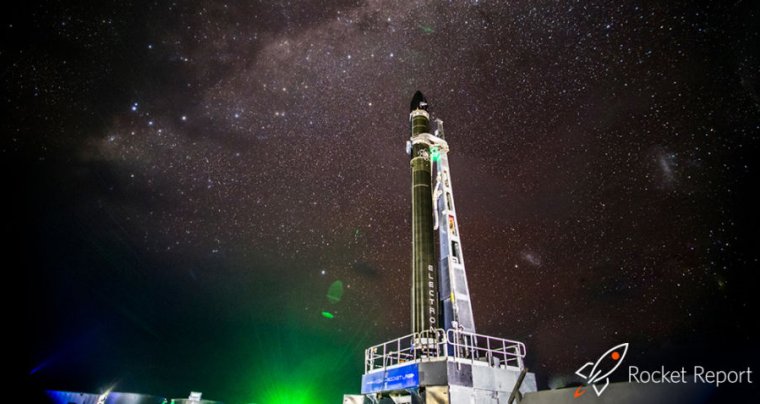

reader comments
181 with 52 posters participating
Welcome to Edition 2.01 of the Rocket Report! This week marks one year since the first report. What started as an experiment has grown into something that a lot of people read. So thank you for joining. And if you appreciate this weekly report and the effort that goes into it, I encourage you to subscribe to Ars Technica. It doesn’t cost much, and there are perks. But mostly you’ll know you’re supporting independent journalism like this. Thank you for considering it.
As always, we welcome reader submissions, and if you don’t want to miss an issue, please subscribe using the box below (the form will not appear on AMP-enabled versions of the site). Each report will include information on small-, medium-, and heavy-lift rockets as well as a quick look ahead at the next three launches on the calendar.

Virgin performs full-duration hotfire test. On Tuesday, Virgin Orbit announced that it had performed the “final full-duration, full-scale, full-thrust—hell, full everything—test firing” of its LauncherOne rocket’s first stage. The firing lasted for more than 180 seconds and was entirely successful, the company reported. Virgin said the rocket, which will be launched from beneath the wing of an airplane, was within an “arm’s reach” of its first orbital flight test.
Time to fly … With the full-duration hotfire test completed, Virgin officials said they have now tested every single aspect of the LauncherOne rocket, from hardware through software, on ground-based stands. All that remains between now and the orbital test flight is final assembly of the first rocket and a few additional test flights of Virgin’s modified 747, Cosmic Girl. We’ll hope for a launch sometime this summer.
College rocket reaches space. Probably. In April, a team of students from the University of Southern California launched its “Traveler IV” rocket from Spaceport America. The vehicle reached a maximum velocity of Mach 5.1, and the students estimated its altitude exceeded the Karman line of 100km. But they’re not 100 percent sure.
Better data needed … The rocket has a diameter of just 20cm, so the rocket’s altitude had to be estimated after the fact from a post-flight analysis based on data collected by Traveler IV’s avionics. The goal was to reconstruct the vehicle’s flight path and determine its apogee. Based upon Monte Carlo flight simulations, the student team estimates the rocket exceeded 100km with 90 percent confidence. “The quality of the recovered dataset requires improvement before the next flight,” the students acknowledged in their analysis. Regardless of the actual altitude, this was an impressive achievement by the USC students. (submitted by Ars Lurker and Ken the Bin)
An Alabama startup’s rocket looks familiar. A company called Earth to Sky says it will offer “first-class service” to low Earth orbit with its “Sleek Eagle” rocket. The booster has a capacity of 1.2 tons to low Earth orbit and a price tag of $14 million, according to Earth to Sky’s website.
Is that a Falcon Heavy Lite? … What struck us about the vehicle is that it looks a lot like the (much larger) Falcon Heavy booster built by SpaceX. The fuel appears to be similar, too, as the Sleek Eagle utilizes a pressure-fed liquid oxygen/kerosene propulsion system. Alas, we are not sure we’ll ever see the Sleek Eagle fly, despite the sleek website design.

Long March 4C launch failure. On Thursday, more than 14 hours after liftoff, Chinese state media confirmed a launch failure of China’s medium-sized Long March 4C rocket. The payload was Yaogan-33, likely a military reconnaissance satellite, and it failed to reach orbit after an issue with the rocket’s third stage. The launch occurred from China’s Taiyuan-based facility.
Had been a busy year … This is the second failure of the Long March 4C booster, which has a capacity of 4.2 tons to low Earth orbit, in the last seven missions. (Overall, the rocket now has a record of 24 out of 26 successful flights). It is unclear what effect a failure would have on Chinese launch plans for this year, as sources in the country have reported it planned 10 launches of the Long March 4 family of rockets in 2019, and this was only the second attempt. (submitted by Ken the Bin)
Engineer faked inspection reports for Falcon rockets. New York prosecutors say an engineer in Rochester falsified inspection reports for payload-fairing components purchased by SpaceX for its Falcon 9 and Falcon Heavy rockets. Prosecutors say the suspect, James Smalley, worked as a quality-assurance engineer for PMI Industries, according to Rochester First.
Relationship ends … After an audit in February 2018, officials found that Smalley faked at least 38 source inspection reports. In court documents, prosecutors say Smalley admitted to copying the signatures of other inspectors onto reports. When asked why he did it, Smalley said he wanted to “ship more product for the company.” SpaceX has terminated its relationship with PMI. (submitted by GE, Ken the Bin, and JohnCarter17).
US launch companies not worrying about China. Even though more than a dozen launch startups have sprouted in China, each attempting a different approach to rocketry, executives with American companies said they’re not worried about potential competition from them, SpaceNews reports. Some in the industry believe that, should some of those companies be successful, they could offer launches at significantly lower prices than American or other Western vehicles.
We won’t be undersold … Relativity CEO Tim Ellis, however, said his company’s Terran 1 rocket will not be undercut by Chinese vehicles on price. The company is offering launches of the Terran 1, which can place up to 1,250kg into low Earth orbit, for $10 million each. “When we’ve looked at price competition,” Ellis said, “we can be competitive with Chinese launchers.” In the coming years there will be a fierce competition for commercial small-satellite launch, but this probably will only be one-third to one-half of the overall market. Government launches will be another big segment of smallsat launch, and it stands to reason that large governments such as China and the United States will want at least one or two low-cost, indigenous smallsat launch companies to survive. (submitted by Ken the Bin)
There’s a new push to market the Proton rocket. Beset by recent failures and the rise of low-cost rivals, the US-based International Launch Services has touted a new relationship with the Russian space agency and Glavkosmos as a means to drive down Proton rocket prices. ILS is responsible for commercial sales of the Proton rocket, and the new governance scheme gives ILS a cozier relationship with Roscosmos, Spaceflight Now reports.
A “difficult” market … “We believe that this now helps us create a new set of products, set of processes, that will allow us to compete more effectively,” Kirk Pysher, president of ILS, said during a news briefing at the Satellite conference in Washington DC. “It’s a difficult market, but the reality is Proton isn’t going to go away. It’s still going to be there flying, so let’s see if we can try to make some money from it on a commercial basis.” Good luck with that.

SpaceX sues government over Air Force awards. A week ago, SpaceX filed a lawsuit under seal, but Geek Wire first reported the protest concerned an Air Force rocket-development contract that was awarded last October to United Launch Alliance, Northrop Grumman, and Blue Origin. SpaceX was left out of the contract awards, presumably because it asked for funding for its Starship project, which the military was not interested in funding. The full complaint was released Wednesday, and it makes for interesting reading. Essentially, the suit represents a harshly worded condemnation of the Air Force’s criteria for selecting launch providers and is especially critical of what SpaceX contends is an institutional bias toward longtime launch provider ULA.
Others join in … Blue Origin and a United Launch Alliance subsidiary also filed motions in the US Court of Federal Claims saying they wanted to take part in the court proceedings because a decision that goes SpaceX’s way may result in financial losses for them. SpaceX has had some success with these kinds of lawsuits in the past, but not always. The new lawsuit comes as the Air Force weighs which two providers it will select for national defense launches from 2022 through 2026. (submitted by NezumiRho, Ken the Bin, and JohnCarter17)
NASA’s full Artemis Moon landing plan revealed. It’s ambitious. This decade-long plan, which entails 37 launches of private and NASA rockets, as well as a mix of robotic and human landers, culminates with a “Lunar Surface Asset Deployment” in 2028, likely the beginning of a surface outpost for long-duration crew stays.
Big hurdles remain … One thing missing is its cost. NASA Administrator Jim Bridenstine has asked for an additional $1.6 billion in fiscal year 2020 as a down payment to jump-start lander development. But all of the missions in this chart would cost much, much more. Sources continue to tell Ars that the internal projected cost is $6 billion to $8 billion per year on top of NASA’s existing budget of about $20 billion.
Vulcan Centaur completes final design review. United Launch Alliance said it has completed an important milestone with the conclusion of the Critical Design Review for the company’s new Vulcan Centaur rocket. The system-level CDR is the final review of the design for the overall rocket.
Still eyeing 2021 … “This is a tremendous accomplishment for the ULA team and a significant milestone in the development of a rocket, signaling the completion of the design phase and start of formal qualification,” said Tory Bruno, ULA’s president and CEO. The company says the new rocket will make its first flight in “less than two years.” (submitted by Unrulycow and Ken the Bin)
Apollo 50th-anniversary season begins soon. We’ve been inundated with announcements about books, movies, podcasts, and events to commemorate the upcoming 50th anniversary of the Apollo 11 Moon landing. Certainly this is a historic event that deserves celebrating, but it’s all a little overwhelming. With that said, we’ll be sharing some of our favorite things related to the anniversary.
Collins, Bezos, and a Kennedy … One of the coolest events has to be on June 19 at the Boston-based John F. Kennedy Library, during which former Ambassador Caroline Kennedy will host Blue Origin Founder Jeff Bezos and Apollo 11 Lunar Command Module pilot Michael Collins, among others. Kennedy’s father, of course, set NASA on a course to the Moon; Collins flew the spaceship there in 1969, and Bezos may self-fund critical aspects of a human return.
Next three launches
May 24: Falcon 9 | Starlink mission | Cape Canaveral, Fla. | 02:30 UTC
May 27: Soyuz 2.1b | Glonass-M satellite | Plesetsk Cosmodrome, Russia | 06:00 UTC
May 30: Proton-M | Yamal 601 telecom satellite | Baikonur Cosmodrome, Kazakhstan | 17:42 UTC



